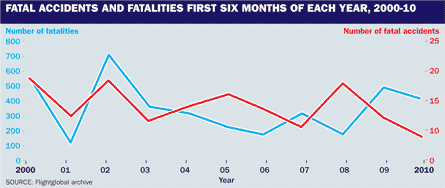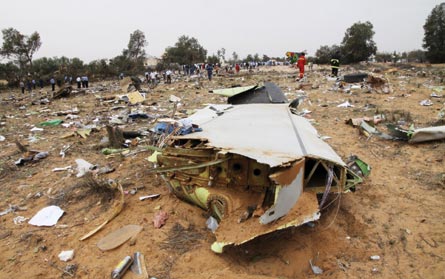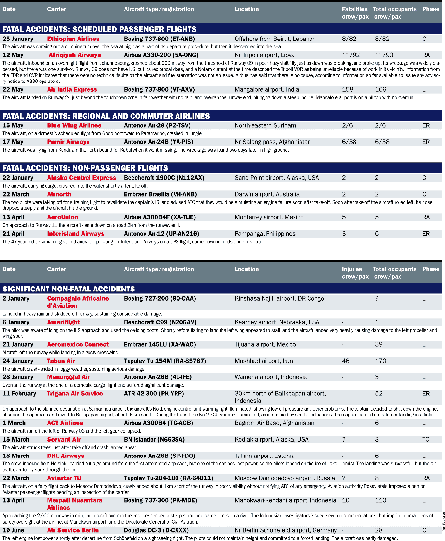A snapshot of global airline fatal accident figures for the first half of 2010 continues an established trend indicating that airline safety performance has stagnated at 2003 levels. This is significant because, until then, airline accident rates had declined steadily since airline flying began.
From January to June airlines suffered nine fatal accidents in which 415 people died. This compares favourably with the first six months of 2009, for which the figures were respectively 13 and 499, but the trend for the period is more or less flat comparing the same period each year over the past decade (see graph).
With only nine fatal accidents in the first six months, 2010 so far shows the lowest figure for a decade. Looking behind the numbers, however, all the improvement stemmed from a drop in fatal accidents to non-passenger flights, but there were just as many fatal accidents as usual in the passenger category.
|
|---|
Non-passenger journeys include freight, airline training, positioning/ferry and post-maintenance test flights. The reduction in fatal accidents in the non-passenger category will be welcomed by the authorities - especially if sustained for the whole year - as this sector has always shown a much higher accident rate than the passenger sector. But if it is not sustained, the six-month improvement on its own has little statistical significance.
The most serious accidents this year to 30 June have been the Ethiopian Airlines Boeing 737-800 crash into the sea off Beirut in January, the Afriqiyah Airways Airbus A330 accident at Tripoli and the Air India Express 737-800 fatal overrun at Mangalore in May (see accident list below).

The Ethiopian 737 was the seventh fatal airline accident since 2000 in which an aircraft had gone out of control over the sea at night. These have killed 976 people. In cases where the results of the investigation have been published it has been established that the cause was loss of control, precipitated by pilot disorientation or loss of situational awareness. It has been established that no technical fault preceded the loss of control of the Ethiopian 737, so the similarity is compelling. The accident report into the May 2007 Kenya Airways Boeing 737-800 accident just after a night take-off at Douala, Cameroon says it was caused by disorientation leading to loss of control (see below). That accident added 114 more deaths to the loss-of-control total.
The 737-800 began descending toward the sea a couple of minutes after take-off, and the crew was making a climbing turn to the right. That turn took the heading out to seaward, so all sight of city lights on land would have been lost to the pilots. Arguments for the regular training of pilots in recovery from unusual attitudes are gaining weight, but in the light of these accidents it would seem wise to train pilots to recognise situations in which the risk of disorientation is high so they can prevent it developing. Climbing turns over the sea at night, especially soon after take-off, would top the list of disorientation risk-bearing situations.
Early reports from the Afriqiyah A330 crash on approach to Tripoli in dawn haze giving poor visibility show no evidence of technical malfunction. The aircraft was smashed into small pieces upon contact with the ground, making loss of control look potentially likely. An aircraft in a controlled descent at normal approach speeds and rates of descent would not have suffered damage like this. Investigators will be looking at flightcrew fatigue as a potential contributory factor as the flight was a long overnight trip from Johannesburg.
The Air India Express Mangalore accident adds to the long list of serious runway overruns - the most common air transport accident - and the only slightly shorter list of fatal runway overruns. It will fuel debate about the need for runway end safety areas, but since Mangalore is a hilltop airfield and the runway cannot be lengthened, its usable length would need to be shortened to provide a safety area. Of 12 significant non-fatal accidents to 30 June, five were runway overruns or excursions on landing.
If there is a message for commercial air transport in this year's results so far, it is that the industry seems to have run out of ideas to keep improvement going. The recurring runway overruns and loss of control accidents signal a need for specific remedies.
ACCIDENT REPORT PUBLISHED IN FIRST SIX MONTHS OF 2010
- On 30 August 2008 a Conviasa Boeing 737-200 crashed on approach to Latacunga, Ecuador. The aircraft was on a ferry flight, and all three on board were killed. Investigators found that the crew, inbound from Maiquetia, had been expecting a straight-in approach from the north, to Runway 18. But air traffic control instead cleared them for a different let-down, requiring the aircraft to overfly the VOR south of the airport, make a 180° right turn, then head north and descend to 13,000ft (3,970m) until intercepting the VOR's 340 radial. From this point the procedure required another 180° right turn and descent on to the final approach path. The aircraft correctly overflew the VOR at 15,000ft, but as it made the initial 180° turn to the north, the aircraft did not follow the published arc. It flew a wider turn and ended up 7nm (13km) west of the VOR instead of 4nm. In its final report, the inquiry board says the pilots had failed to carry out the turn at the correct speed, configuration and bank angle. The crew "did not notice" that the poorly conducted turn put the aircraft "outside the protected airspace" in a mountainous area. The aircraft travelled further along the northbound leg than it should have before encountering the VOR radial. Flying in darkness, the crew informed ATC that they were beginning the second 180° right turn that would normally have brought the 737 on to the runway extended centreline, but instead it collided with the Illiniza Sur volcano at an elevation of 13,100ft. The aircraft's flight recorders show that a ground-proximity warning sounded 22s before the impact, but the crew "did not execute an escape manoeuvre", says the inquiry board.
- Turkish Airlines has expressed reservations about some of the conclusions of the Dutch inquiry into the 25 February 2009 Amsterdam Boeing 737 crash, notably over the crew's failed attempt to recover from the fatal stall. The inquiry found that the first officer, the flying pilot, responded immediately to the stickshaker by pushing the control column and thrust levers forward, in line with stall-recovery procedures. But cockpit voice recorder analysis shows that the captain also called that he was taking control, just as the thrust levers had been pushed halfway forward. "Assumingly, the result of this was that the first officer's selection of thrust was interrupted," says the final report into the crash. Crucially, as the first officer relinquished the thrust levers to hand over control, the still-engaged autothrottle immediately retarded them to the idle position. Unnoticed by the pilots, the autothrottle had gone into "retard flare" mode because of a link to the faulty radio altimeter, which was indicating that the aircraft had already reached the runway elevation. "Directly thereafter, the autothrottle was disengaged," says the report. "But for a period of 7s the thrust levers were not moved forwards from the idle position." While the investigation could not determine whether the captain had placed his hands on the thrust levers, it says that 9s passed between the activation of the stickshaker and the manual movement of the thrust levers to maximum. By this point the aircraft had already stalled and the remaining height of 350ft was "insufficient for the recovery procedure". Turkish Airlines says the autothrottle "kicked back unexpectedly" and that Boeing "had not mentioned", in its documentation, a need to disconnect the autothrottle during the procedure. The carrier describes the relationship between the left-hand radio altimeter and the autothrottle as "error-prone", adding that it was not explained in Boeing's documentation for flightcrews until after the crash. The safety board highlighted the problems of incomplete knowledge of the aircraft's interdependent systems. It points to the crew's suffering from "automation surprise" with respect to the autothrottle's behaviour - during both the original loss of thrust on approach and the attempted stall recovery. Turkish Airlines also claims that simulator tests show that a height of at least 500ft is required for the 737-800 to recover successfully from a stall, and that the ill-fated jet was already below this level when the pilots initiated the recovery procedure.
- Investigators report that the 5 May 2007 Kenya Airways Boeing 737-800 accident just after a night take-off from Douala, Cameroon, was the result of loss of control caused by disorientation. Soon after take-off the aircraft showed a tendency to roll right, but the captain - the pilot flying - corrected it. After 42s the captain indicated that the autopilot should be engaged, but it did not. The aircraft began banking right until, at 34°, the "bank angle" spoken warning activated. The captain expressed surprise, and his first input was further right aileron, followed by confused inputs. The co-pilot attempted to intervene in the correct sense, but the captain's inputs worsened the situation, until the aircraft hit the ground 1min 42s after take-off with a 48° nose-down attitude and 115° bank.
- A Russian court has ruled that the captain of an Aeroflot-Nord Boeing 737-500 that crashed on a night approach to Perm in marginal weather in September 2008 was intoxicated, and that this had led to disorientation, which caused the fatal accident. The investigators also found that misaligned throttle levers and differences in artificial horizon presentation in the fleet contributed to the crew's problems.
|
|---|
ACCIDENTS AND INCIDENTS, JANUARY - JUNE 2010
Accident data comes from Flight International's own research, sister online publication Air Transport Intelligence and from our database service Flightglobal ACASÕs daily occurrence information. Details of non-fatal incidents are not made available officially by the authorities in many countries, but Flight International continues to list as many significant incidents as possible, in the interests of maximising the availability of relevant information. We accept the non-fatal listing may be weighted against the airlines of those countries that make safety information more readily available.
GLOSSARY OF TERMS AND ABBREVIATIONS
AA airfield approach/early descent
AAIB UK Air Accidents Investigation Branch
AAL above airfield level
ADC air-data computer
ADF automatic direction finder
AF air force
AGL above ground level
AMSL above mean sea level
AOA angle of attack
ASB alert service bulletin
ASI airspeed indicator
ATC air traffic control
C climb
C-B circuit breaker
CFIT controlled flight into terrain
CNK cause not known
CVR cockpit voice recorder
DFDR digital flight data recorder
DME distance measuring equipment
ECAM electronic centralised aircraft monitor
EFIS electronic flight-instrument system
EGPWS enhanced ground proximity warning system
EGT exhaust gas temperature
EICAS engine indicating and crew alerting system
ER en route
ETOPS extended-range twin operations
FAA US Federal Aviation Administration
FDR flight data recorder
FL flight level = altitude, in hundreds of feet, with international standard pressure-setting (ISA) of 1013.2mb set on altimeter (eg: FL100 =altimeter reading of 10,000ft withb ISA set)
FMS flight management system
G on ground
GPU ground power unit
GPWS ground proximity warning system
HP high pressure
IFR instrument flight rules
IMC instrument meteorological conditions
ILS instrument-landing system
ISA international standard atmosphere = sea level pressure of 1013.2mb and standard temperature/pressure lapse rate with altitude
L landing
LP low pressure
MEL minimum equipment list
MDC McDonnell Douglas
MTOW maximum take-off weight
NDB non-directional beacon
NTSB US National Transportation Safety Board
PAPI precision approach path indicator
PAX passengers
PF pilot flying
PNF pilot not flying
RA runway/final approach
RNAV area navigation
SB service bulletin
SID standard instrument departure
TAWS terrain awareness and warning system
TO take-off
TOGA press-button selected take-off/go-around thrust
VASI visual approach slope indicator
VFR visual flight rules
VHF very high frequency
VMC visual meteorological conditions
VOR VHF omni-range navigation beacon
V1 take-off decision speed
CONVERSION FACTORS
1nm = 1.85km
1ft = 0.3m
1kt = 1.85km/h
Source: Flight International



















